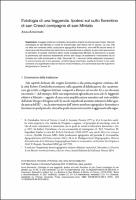Chapter Eziologia di una leggenda. Ipotesi sul culto fiorentino di san Cresci compagno di san Miniato
| dc.contributor.author | Benvenuti, Anna | |
| dc.date.accessioned | 2022-06-01T12:25:23Z | |
| dc.date.available | 2022-06-01T12:25:23Z | |
| dc.date.issued | 2021 | |
| dc.identifier | ONIX_20220601_9788855182959_660 | |
| dc.identifier.uri | https://library.oapen.org/handle/20.500.12657/56475 | |
| dc.description.abstract | The essay analyses the cult of St. Cresci and its origins. St. Cresci is considered to be one of the companions of St. Miniato, and it is believed he was martyred ‘sub Decio’ in the 3rd century. St. Cresci’s legend must be interpreted in the context of the Florentine hagiographic production of the 11th century, when the local clergy tried to resuscitate old and long forgotten cults of saints whose relics they possessed. The paper argues that the legend of St. Cresci was ‘invented’ to be opposed to that of St. Miniato. Indeed in the 11th century Ildebrando, bishop of Florence, strongly promoted the cult of Minias in order to support his claims on the lands of the newly founded monastery. It was after this that cathedral’s canons, in opposition with their bishop, proposed the martyrial figure of St. Cresci; the cult of which got a great importance under the Medici, and especially during the reign of Cosimo III. | |
| dc.language | Italian | |
| dc.relation.ispartofseries | Fragmentaria. Studi di storia culturale e antropologia religiosa | |
| dc.subject.other | Florentine hagiography | |
| dc.subject.other | San Cresci | |
| dc.subject.other | San Miniato | |
| dc.subject.other | Florentine episcopate | |
| dc.subject.other | Cosimo III of Tuscany | |
| dc.title | Chapter Eziologia di una leggenda. Ipotesi sul culto fiorentino di san Cresci compagno di san Miniato | |
| dc.type | chapter | |
| oapen.identifier.doi | 10.36253/978-88-5518-295-9.05 | |
| oapen.relation.isPublishedBy | bf65d21a-78e5-4ba2-983a-dbfa90962870 | |
| oapen.relation.isbn | 9788855182959 | |
| oapen.series.number | 2 | |
| oapen.pages | 24 | |
| oapen.place.publication | Florence |

